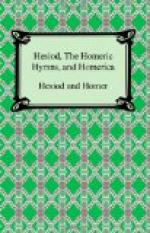((LACUNA))
Oxyrhynchus Papyri 1359 fr. 3 (early 3rd cent. A.D.): (ll. 17-24) (68) ....Cleopatra ....the daughter of.... ....But an eagle caught up Ganymede for Zeus because he vied with the immortals in beauty.... ....rich-tressed Diomede; and she bare Hyacinthus, the blameless one and strong.... ....whom, on a time Phoebus himself slew unwittingly with a ruthless disk....
ENDNOTES:
(1) A catalogue of heroines each of whom was introduced
with the
words E OIE, `Or like
her’.
(2) An antiquarian writer of Byzantium, c. 490-570
A.D.
(3) Constantine VII. `Born in the Porphyry Chamber’,
905-959
A.D.
(4) “Berlin Papyri”, 7497 (left-hand
fragment) and “Oxyrhynchus
Papyri”, 421 (right-hand
fragment). For the restoration see
“Class. Quart.”
vii. 217-8.
(5) As the price to be given to her father for her:
so in
“Iliad”
xviii. 593 maidens are called `earners of oxen’.
Possibly Glaucus, like
Aias (fr. 68, ll. 55 ff.), raided the
cattle of others.
(6) i.e. Glaucus should father the children
of others. The
curse of Aphrodite on
the daughters of Tyndareus (fr. 67)
may be compared.
(7) Porphyry, scholar, mathematician, philosopher
and historian,
lived 233-305 (?) A.D.
He was a pupil of the neo-Platonist
Plotinus.
(8) Author of a geographical lexicon, produced after
400 A.D.,
and abridged under Justinian.
(9) Archbishop of Thessalonica 1175-1192 (?) A.D.,
author of
commentaries on Pindar
and on the “Iliad” and “Odyssey”.
(10) In the earliest times a loin-cloth was worn by
athletes, but
was discarded after
the 14th Olympiad.
(11) Slight remains of five lines precede line 1 in
the original:
after line 20 an unknown
number of lines have been lost, and
traces of a verse preceding
line 21 are here omitted.
Between lines 29 and
30 are fragments of six verses which do
not suggest any definite
restoration. (NOTE: Line
enumeration is that
according to Evelyn-White; a slightly
different line numbering
system is adopted in the original
publication of this
fragment. — DBK)
(12) The end of Schoeneus’ speech, the preparations
and the
beginning of the race
are lost.
(13) Of the three which Aphrodite gave him to enable
him to
overcome Atalanta.
(14) The geographer; fl. c.24 B.C.
(15) Of Miletus, flourished about 520 B.C. His
work, a mixture
of history and geography,
was used by Herodotus.
(16) The Hesiodic story of the daughters of Proetus
can be
reconstructed from these
sources. They were sought in
marriage by all the
Greeks (Pauhellenes), but having
offended Dionysus (or,
according to Servius, Juno), were
afflicted with a disease
which destroyed their beauty (or




